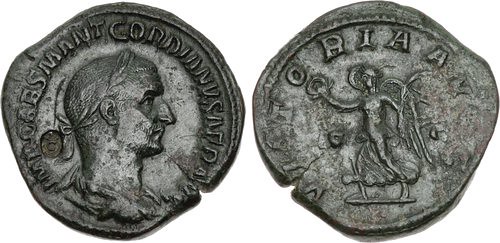
PREV ARTICLE
NEXT ARTICLE
FULL ISSUE
PREV FULL ISSUE
IS THE CROWNED C QUEEN CHRISTINA'S COUNTERMARK?Our June 24, 2018 article mentioning Queen Christina of Sweden prompted Jim Duncan to ask for information on a countermark
thought to identify coins from her collection. -Editor
Jim wrote: In 2014 I gave a paper on Women in Numismatics I referred to Christina, and I understood that she left Sweden with her collection when she decamped for The Vatican. It's nice to see something in writing – even though it does not mention a collection. I also understood that she had each piece in her collection stamped with a tiny crowned C. Be grateful to know which is fact and fiction! Here are some reader responses, beginning with an example of the crowned C countermark. Mary Lannin and Hadrien Rambach located
this in Classical Numismatic Group's 93rd sale. -Editor
Gordian I Sestertius  CNG 93, Lot: 1210. Estimate $3000. Sold for $6000. This amount does not include the buyer's fee. Gordian I. AD 238. AE Sestertius (31mm, 17.80 g, 12h). Rome mint. IMP CAES M ANT GORDIANVS AFR AVG, laureate, draped and cuirassed bust right; c/m: crowned C / VICTORIA AVGG, Victory advancing left, holding wreath in extended right hand and cradling palm frond in left arm; S C across field. RIC IV 12; BMCRE 14-16; Banti 8; Havercamp, Numophylacium Reginae Christinae (The Hague, 1742), p. 235, III, pl. XXXIII (this coin); Cohen 14. VF, green patina, some red, edge split and hairline flan crack. Ex Robert Schonwalter Collection (Triton V, 15 January 2002), lot 2053; Münzen und Medaillen AG 61 (7 October 1982), lot 466; Hess-Leu 41 (24 April 1969), lot 419; Queen Christina of Sweden Collection (reigned 1632-1654). In 1654, Queen Christina abdicated and moved to Rome, taking with her an immense coin collection of more than 15,000 coins, some of which she had inherited. She patronized a group of prominent numismatists of the time, and when she died, she bequethed more than 6000 coins to the Odescalchi family, and these coins were later sold to Pope Pius VI for the Vatican's coin cabinet. Her coins are easily identifiable by the crowned C stamped on them, and are some of the oldest and most prestigiously pedigreed coins. To read the complete lot description, see: Ex Collection of Queen Christina of Sweden Doubts Emerge Hadrien Rambach also submitted this excerpt from a paper he published on the topic. Thank you. I've used Google Translate to
get an English version, but included the original for those who read French, -Editor
Il est rarissime de mettre une contremarque de propriété sur une monnaie de collection, car cela en affecte l'état de conservation6. Un exemple notable est un «C couronné», pas encore identifié, qui a longtemps été considéré à tort être la marque de propriété de la reine Christine de Suède (1632-1654). Curtis L. Clay a argumenté de façon convaincante que cette contremarque n'est pas celle de la reine: en effet, la majorité de ses pièces furent vendues par ses héritiers au Vatican, et nombre d'entre-elles furent confisquées par l'armée napoléonienne et ramenées à Paris, où elles peuvent être identifiées à partir de l'ouvrage Médailles de grand et moyen bronze du cabinet de la Reine Christine de Sigebert Havercamp (La Haye 1742) mais ne sont pas contremarquées. L'hypothèse que cette marque soit celle du roi Charles I d'Angleterre ne semble pas non plus convaincante9, pas plus que celle du poinçon français des objets en mélange cuivreux pour 1745-1749. English Translation: It is extremely rare to put a property countermark on a currency of collection because it affects the state of conservation. A notable example is a "crowned C", not yet identified, which has long been wrongly considered to be the mark of property of Queen Christina of Sweden (1632-1654). Curtis L. Clay argued convincingly that this countermark is not that of the queen: indeed, the majority of her pieces were sold by her Heirs at the Vatican, and many of them were confiscated by the army Napoleon and brought back to Paris, where they can be identified from Queen's Medium and Large Medal Medals Queen's Cabinet Christine de Sigebert Havercamp (The Hague 1742) but are not countermarked. The assumption that this mark is that of King Charles I of England does not seem convincing either, nor does that of the French punch objects in copper mixture for 1745-1749. From : Hadrien Rambach, « Un aigle contremarqué sur un dupondius de Titus appartenant à la Bibliothèque royale de Belgique, signe d'une provenance d'Este à Ferrare », in In Monte Artium, vol. 10 (2017), pp. 103-117 English Translation: From: Hadrien Rambach, "A countermarked eagle on a Titus dupondius belonging to the Royal Library of Belgium, sign of provenance from Este to Ferrara ", in Monte Artium, vol. 10 (2017), pp. 103-117 Mary Lannin adds: One thing to keep in mind is that you had to be very wealthy in the 17th century to collect.....a king or a queen. It may not belong to Christina or Charles, but certainly to someone of great wealth whose mysterious ego confounds collectors today. So it seems in doubt that the crowned C connects coins to the cabinet of Queen Cristina of Sweden. But it's still not clear
who was responsible for it. Perhaps future research will shed more light on this. Thanks, everyone. -Editor
To read the earlier E-Sylum articles, see:  Wayne Homren, Editor The Numismatic Bibliomania Society is a non-profit organization promoting numismatic literature. See our web site at coinbooks.org. To submit items for publication in The E-Sylum, write to the Editor at this address: whomren@gmail.com To subscribe go to: https://my.binhost.com/lists/listinfo/esylum All Rights Reserved. NBS Home Page Contact the NBS webmaster 
|